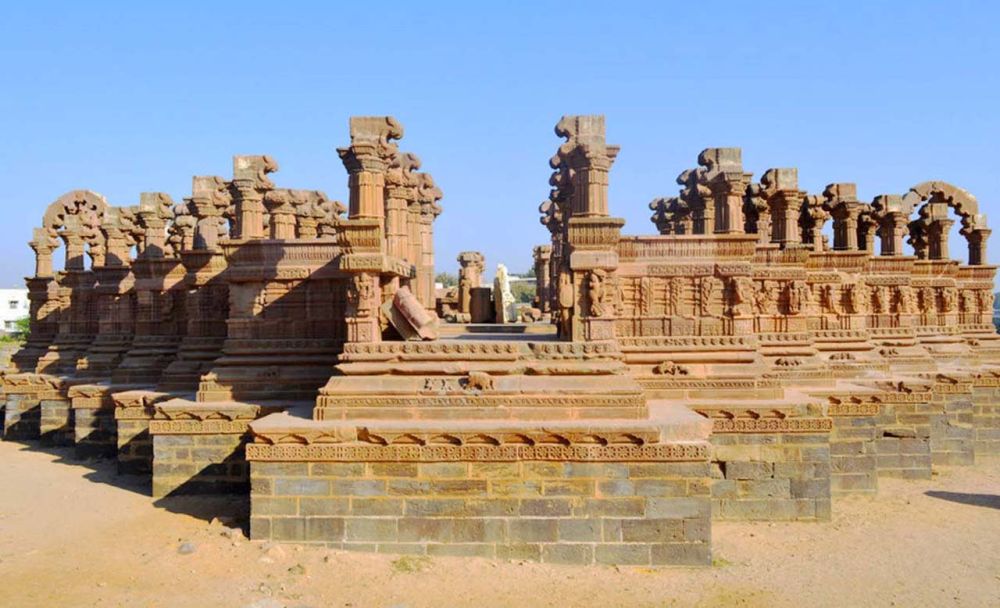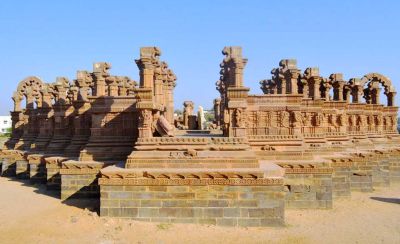

The White Rann of Kutch, known for its surreal and enchanting white salt desert, is a must-visit attraction near Bhuj, Gujarat. This vast expanse of sparkling white salt creates a mesmerizing landscape that transforms under the changing skies. In winter, during the Rann Utsav festival, the region comes alive with folk dances, cultural performances, and handicraft markets, offering visitors a unique insight into the local culture. A trip to the White Rann typically includes a visit to the nearby Dhordo village, where tourists can experience the hospitality of the Kutchi people, stay in traditional Bhunga huts, and enjoy local cuisine. Adventurous travelers can indulge in activities like hot air ballooning, camel safaris, and ATV rides. A visit here is usually timed to coincide with sunset or sunrise when the beauty of the White Rann is most profound. Please note that permits are required to visit this area, so it's advisable to arrange them in advance through your tour operator or at the permit office in Bhirandiyara.
The Aina Mahal and Prag Mahal, located in Bhuj, are testament to the region's historical grandeur and a blend of Indian and European architectural styles. The Aina Mahal, or 'Palace of Mirrors,' was built in the 18th century and is decorated with beautiful glasswork and mirrors that give it a distinctive charm. It also houses a museum showcasing royal artifacts. Adjacent to it is the Prag Mahal, a 19th-century Italian-Gothic structure with a remarkable bell tower that offers panoramic views of the city. A visit to these palaces provides a glimpse into the lives of the erstwhile rulers of Kutch and the region's rich history. The intricate craftsmanship and architectural nuances here are sure to captivate history buffs and architecture enthusiasts alike. These palaces were partially damaged in the 2001 earthquake, but restoration efforts have ensured that their legacy continues.
Located in Bhuj, the Kutch Museum is Gujarat's oldest museum, founded in 1877. It showcases a splendid collection of artifacts that represent the cultural heritage of the Kutch region. The museum houses a variety of exhibits, including ancient coins, Kutchi scripts, tribal crafts, embroidery, and a section on natural history. One can also find models depicting traditional Kutchi villages, costumes, and detailed information on the local tribes and their lifestyles. The Kutch Museum offers a deep dive into the region's history, archaeology, and ethnography, making it a treasure trove for those interested in cultural exploration. A visit here is often an educational journey that provides valuable insights into the unique and diverse blend of communities in Kutch.
Bhujodi is a small town around 8 km from Bhuj, renowned for its artisans and handicrafts. The Handicraft Village here is a hub for textile enthusiasts and those looking to purchase authentic Kutchi handiwork directly from the artisans. You can find beautifully crafted items such as shawls, bandhani sarees, traditional embroidered clothing, and colorful home decor. The craftsmen in Bhujodi are skilled in weaving, block-printing, and dyeing, and are known for their intricate embroidery techniques. Visitors can interact with the artisans, watch live demonstrations, and learn about the traditional methods practiced for generations. Visiting Bhujodi provides not only an opportunity to acquire unique souvenirs but also the chance to support the local craft communities. The warm hospitality of the villagers adds to the memorable experience.
Embark on a culinary adventure in Bhuj by discovering the flavors of Kutchi cuisine. Famed for its variety and taste, Kutchi food is a blend of flavors that caters to both vegetarians and non-vegetarians. Traditional dishes like Kutchi Dabeli, a local version of a burger made with spiced mashed potatoes, Khaman Dhokla, a gram flour-based steamed cake, Bajri no Rotlo, a millet flatbread typically served with garlic chutney, and the flavorful Khichdi are all worth trying. A culinary walking tour in Bhuj allows you to explore the city's food corners, street food vendors, and local restaurants. Visitors can indulge in savory snacks, sweet delicacies, and a range of beverages unique to this part of India. Such a tour is not just about eating; it's also about learning the history and cultural significance behind the mouthwatering dishes of Kutch.
The Swaminarayan Temple in Bhuj is an architectural masterpiece and a significant religious site for the followers of the Swaminarayan faith. The temple complex is a marvel of intricate carvings, beautifully constructed archways, and embellishments that represent the exquisite craftsmanship of the local artisans. Originally constructed in the 19th century, the temple underwent reconstruction after the devastating earthquake in 2001. The new structure is not just a sight to behold but also a symbol of resilience and the community's dedication to preserving their heritage. Visitors are welcomed into a serene environment perfect for spiritual introspection or simply appreciating the peace that the temple brings. The temple's serene ambiance and remarkable architecture make it an ideal spot for those seeking tranquility or an interest in spiritual architecture.
Hamirsar Lake is a historic man-made lake in the heart of Bhuj, and it serves as a tranquil oasis amidst the hustle and bustle of the city. This picturesque spot is perfect for evening strolls, picnics, and boating excursions. Around the lake, visitors will find lush gardens and pathways, making it a popular spot for locals to relax under the shade of trees. The lake is also flanked by several important historical structures, providing a scenic backdrop for those looking to soak in the region's past. In addition to its appeal as a recreational area, Hamirsar Lake plays a crucial role in Bhuj's water supply and ecosystem. Spending time by this lake gives you a chance to witness the everyday life of Bhuj's residents and enjoy a quiet moment in nature.
Khamir Platform is an initiative aimed at sustaining and promoting the traditional crafts of the Kutch region. It serves as a space for artisans to come together, collaborate, and showcase their skills. A visit here will enlighten you about the various arts and crafts of the region, including pottery, wood carving, weaving, and embroidery. Khamir provides a platform for artisans to display and sell their products, ensuring that the profits return to the craftsperson. Travelers can take a guided tour of the facility, interact with the artisans, participate in workshops, and buy authentic handcrafted products. The crafts presented here range from everyday utility items to intricate decorative pieces, all of which tell a story of the Kutch culture. Khamir Platform is a must-visit for those who are passionate about supporting local art and sustainable practices.
The Banni Grasslands Reserve, located on the southern edge of the Rann of Kutch, is a unique ecosystem that supports a variety of wildlife and bird species. Spread across an area of about 3,847 square kilometers, it is one of India's largest grassland reserves. Here, nature enthusiasts and birdwatchers can embark on a safari to witness the diversity of the region's fauna, such as the famous Indian wild ass, chinkara, nilgai, and numerous migratory birds. The best time to visit Banni is during the monsoon and winter months when the grasslands are lush, and the water bodies within the reserve attract a large number of birds. It's essential to have an experienced guide or join an organized tour to make the most out of a visit to the Banni Grasslands. The reserve's blend of remarkable biodiversity and natural beauty offers an unforgettable experience for wildlife aficionados.
Sharad Baug Palace is a historical palace located in Bhuj, which once served as the royal residence of Maharao Madansinhji of Kutch until his death in 1991. Today, it houses a museum dedicated to the erstwhile rulers of Kutch and offers a glimpse into the royal way of life. The palace garden, known for its lush flora, is a delightful spot for an evening walk. The museum within the palace showcases exquisite silverware, furniture, and photographs that narrate the story of the royal family's history. A visit to the Sharad Baug Palace is a journey through time as guests marvel at the colonial architectural features and the well-maintained gardens that surround the palace. The tranquility and historical significance of Sharad Baug Palace make it an attractive destination for those interested in the bygone eras and heritage of Kutch.
